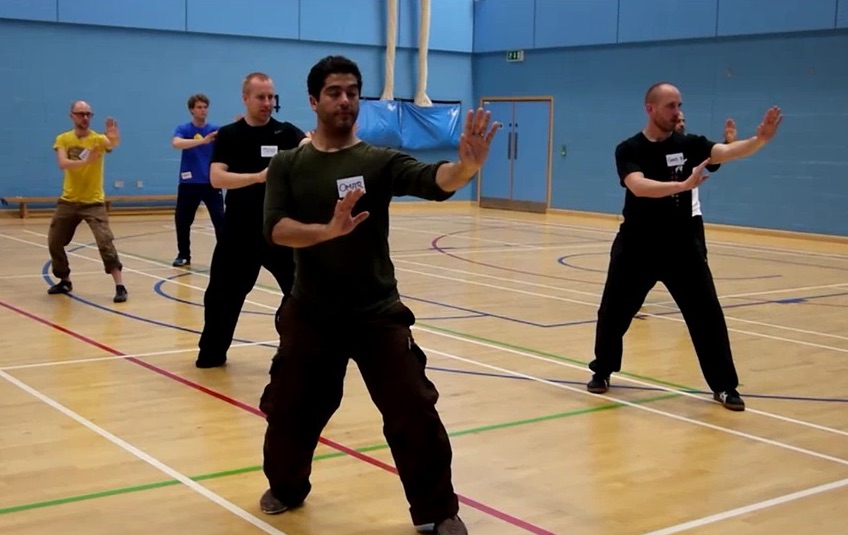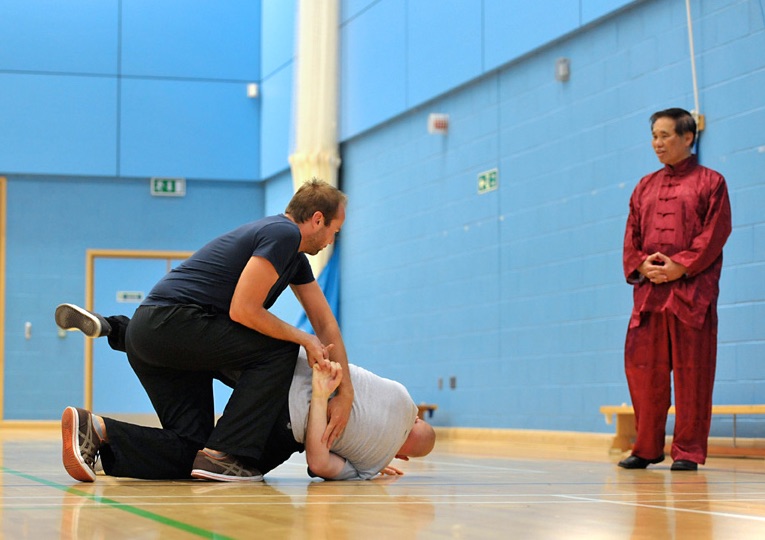THE BREADTH AND DEPTH OF XINGYIQUAN

Would you believe that a Xingyiquan master can counter any attack using just pi-quan?
Question
"It is not because the generals did not know a lot of combat techniques that they practiced Xingyiquan, it was precisely because they knew a lot of combat techniques that they could use Xingyiquan, with its few techniques, effectively." Grandmaster Wong Kiew Kit.
To get the most benefit from training the depth of Xingyiquan, how much spread should a student first have in another art with more techniques (such as Eagle Claw)? If a beginner was to start with Xingyiquan, and have no knowledge of many techniques, would that student find himself/herself limited? Who would be in a better position to train the depth of Xingyiquan -- a student with a lot of experience (in other arts) with an average Sifu or a fresh beginner student with no other experience but with a very good Sifu?
Sifu Matt Fenton
Answer
Xingyiquan is marvelous. It is profundity in simplicity. But one could only appreciate its simplicity when he is already profound.
My own experience would be a good example. Initially I found Xinguyiquan inadequate for combat. I thought Xingyiquan would be effective if an opponent used simple attacks, like what is found in modern day sparring and fighting such as straight-forward punches and kicks.
I thought, wrongly, that if an opponent used sophisticated attacks, like the Shaolin 72 chin-na techniques, a Xingyiquan exponent would have much difficulty. He would have to depend on his tremendous internal force to counter sophisticated attacks. These ideas occurred to me at a time when I was already quite accomplished, when I could defeat other martial artists, including masters, quite comfortably.
It was only recently (about 2012) when I prepared to teach Xingyiquan and researched deeply into the art that I had my Xingyiquan “enlightenment”, that I suddenly realized Xingyiquan was effective against any attack, including very sophisticated ones.
Without false modesty, it is not unreasonable to believe that if I could not see the profundity of Xingyiquan at a time when I was already quite accomplished in martial art, not many people, including Xingyiquan masters today, would also be unable to see its profundity.
Their inability to see the profundity of Xingyiquan is not because they have not practiced Xingyiquan deeply, but because, I believe, this profundity was lost during its transmission, and modern masters did not have the wide understanding of kungfu philosophy to recover it. After all, most kungfu practitioners today, including masters, could not use their kungfu techniques for simple combat, they had to resort to kick-boxing, what more it is to use simple techniques to counter sophisticated attacks.
On hindsight I realize that I already had the wide understanding of kungfu philosophy before, but still did not know the profundity of Xingyiquan because I did not address myself to that question. It was on one fine day when I thought of how to apply Xingyiquan in modern day free sparring competitions that I had a glimpse of its profundity.
This glimpse was a vintage point that opened up to the profundity of Xingyiquan against any attack, including sophisticated ones. It also led me to answer a question I had been thinking in the past, i.e. why did Xingyiquan use the footwork the way it did, which was quite different from other kungfu styles. I discovered that Xingyiquan footwork excellently complimented its profound but simple-looking combat techniques.
With this background, we can better appreciate the answers to the questions below.
- To get the most benefit from training the depth of Xingyiquan, how much spread should a student first have in another art with more techniques (such as Eagle Claw)?
- If a beginner was to start with Xingyiquan, and had no knowledge of many techniques, would that student find himself/herself limited?
- Who would be in a better position to train the depth of Xingyiquan -- a student with a lot of experience (in other arts) with an average sifu or a fresh beginner student with no other experience but with a very good sifu?
If the student has an excellent teacher who understands the depth of Xingyiquan and is willing to teach it, the student needs not have any spread in another art to benefit from the profundity of Xingyiquan. He just follows the teaching of the teacher. The important point here is that the teacher himself must have the profundity as well as the teaching skills to impart the profundity.
If the student has spread, provided that he already has basic skills, he will benefit more than if he had no spread. The wider the spread, i.e. the more techniques and skills from other styles he knows, the better will be his understanding and performance of Xingyiquan in its profundity. If the student does not have basic skills, like good stances, exploding force, fluidity of movement, his spread would be detrimental.
For example, in Xingyiquan the internal force in a strike comes from the shoulder, whereas in most other styles it comes from the dan tian. If he has not learned other styles, a Xingyiquan student can still explode force from his shoulder if his teacher has the methods to teach him.
If the student has also learned from other styles how to explode force from his dan tian, not only he will learn a new method of exploding force from his shoulders, but also his earlier training will enhance his new learning.
Here the teacher must be competent, he has to ensure that the student’s earlier training does not interfere with the new learning, but enhances it. The student must follow the instructions respectfully. If he tries to be smarter than his teacher, and explode force from his dan tian instead of from his shoulders, he may have more force initially but eventually the two methods may contradict each other.
A fresh beginner without any prior experience of martial art will not be limited when he learns Xingyiquan from a good teacher. In fact, when learning Xingyiquan, generally it is better for students to have no martial art experience than have experience. This is because of two reasons.
Xingyiquan is quite different from many other styles of kungfu and other martial arts. Their previous experience is more likely to interfere with rather than help their new Xingyiquan learning.
Secondly, good teachers are rare. Many kungfu teachers are not even mediocre. They teach forms for demonstration and kick-boxing for combat instead of genuine kungfu. Such teachers will not have the knowledge and skills to enable their students not be distracted by their previous experience
This situation does not occur in our school. Our instructors are well trained. Even when fresh beginners learn Xingyiquan from our instructors, the students would not find themselves limited.
A fresh beginner with no experience but with a very good teacher will be in a better position to train the depth of Xingyiquan than another student with a lot of experience in other arts but with an average teacher.
In kungfu training, especially in a profound art like Xingyiquan, a good teacher is generally more important than a good student or a good art. This is mainly because the teacher is the most influential factor in determining what and how a student trains.
Even in a straight-forward external art like Wing Choon, a good teacher will ensure that his students do not sustain injuries in their training, and be able to use Wing Choon for combat. A bad teacher may cause his students a lot of injuries in random free sparring, and use kick-boxing instead of Wing Choon techniques in fighting.
Even when a student may have experience in other arts, his Wing Choon training will be determined by his Wing Choon teacher, and not by what he has learned elsewhere. In a profound art like Xingyiquan, a good teacher is even more important.
In comparing arts, a student will generally get more benefits learning a low-level art from a good teacher, than learning a high-level art from a bad teacher. Xingyiquan is of a higher level than Eagle Claw. The former was for generals, the latter for ordinary soldiers. Actually Eagle Claw is a high level art, but compared to Xingyiquan it is of a lower level.
If a student learns Eagle Claw from a good teacher, the student will be healthy and have vitality, and be able to use Eagle Claw for combat. If he learns Xingyiquan from a bad teacher, he may hurt himself insidiously in his training, and use kick-boxing to fight like children.
Let us now compare Eagle Claw with Boxing. Eagle Claw is a high level art, and Boxing is low level. Many Boxers may disagree.
If a student learns Boxing from a good teacher, the student will be able to use Boxing for combat. He may still be hurt in his training, and in Boxing the injuries are usually left unattended to. But at least the good teacher will teach him how to avoid being hit.
If he learns Eagle Claw from a bad teacher, the student will be unable to use Eagle Claw for combat. He may use kick-boxing randomly in free sparring, and sustain a lot of injuries in his generous exchanges of blows with his sparring partners. The bad teacher will not teach him how to avoid being hit. If he did, he would not be a bad teacher.
The best, of course, is when the three components -- the art, the teacher and the students -- are good. Such an excellent combination occurred when Xingyiquan was taught by Yue Fei to the generals -- a great art, a great teacher and very good students.
We in Shaolin Wahnam can do even better! The generals learned Xingyiquan for only one purpose -- to strike down opponents effectively. Besides combat efficiency we can also have good health, vitality, longevity, mental freshness and spiritual joys from our Xingyiquan practice. We are so used to these benefits that sometimes we forget that these benefits are not attainable by most other martial artists.

The art, the teacher and the student are the three factors determining how advanced a practitioner can achieve
Xingyiquan Questions and Answers
The questions and answers are reproduced from the thread 10 Questions to Sifu about Xingyiquan in the Shaolin Wahnam Discussion Forum.
LINKS
